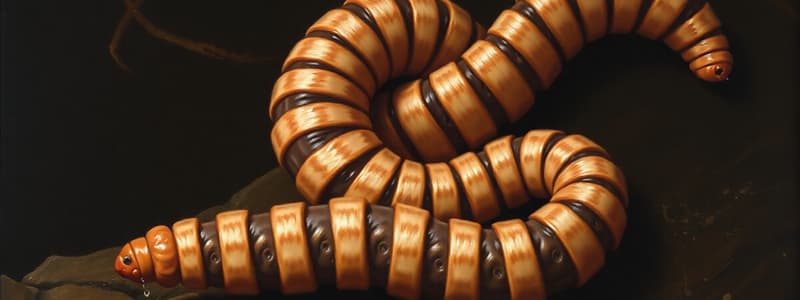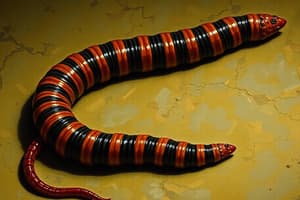Podcast
Questions and Answers
How does the burrowing activity of earthworms contribute to soil health?
How does the burrowing activity of earthworms contribute to soil health?
- It increases soil porosity, allowing air and water to penetrate more easily. (correct)
- It prevents the mixing of surface and deeper soil layers causing soil compaction.
- It depletes the soil of nutrients by consuming organic matter.
- It decreases soil porosity, reducing water penetration.
In annelids, what is the primary function of the gizzard?
In annelids, what is the primary function of the gizzard?
- Secreting digestive enzymes.
- Storing food temporarily.
- Absorbing nutrients into the bloodstream.
- Grinding food particles. (correct)
What is the functional role of aortic arches in earthworms?
What is the functional role of aortic arches in earthworms?
- Oxygenating the blood.
- Absorbing nutrients from the digestive tract.
- Filtering waste from the blood.
- Pumping blood from the dorsal to the ventral vessels. (correct)
What is the main function of metanephridia in annelids?
What is the main function of metanephridia in annelids?
How does the exchange of sperm packets contribute to genetic diversity in annelids?
How does the exchange of sperm packets contribute to genetic diversity in annelids?
How do earthworms enrich the soil?
How do earthworms enrich the soil?
Where does gas exchange primarily occur in earthworms?
Where does gas exchange primarily occur in earthworms?
What is the role of the clitellum in annelid reproduction?
What is the role of the clitellum in annelid reproduction?
If you observed a bright red worm in an oxygen-poor freshwater environment, which respiratory pigment would you expect to find in high concentration in its blood?
If you observed a bright red worm in an oxygen-poor freshwater environment, which respiratory pigment would you expect to find in high concentration in its blood?
How does the closed circulatory system of annelids facilitate efficient transport and exchange?
How does the closed circulatory system of annelids facilitate efficient transport and exchange?
What is a key distinction between digestion in annelids and intracellular digestion?
What is a key distinction between digestion in annelids and intracellular digestion?
The dorsal vessel in earthworms carries blood towards which part of the organism?
The dorsal vessel in earthworms carries blood towards which part of the organism?
What characteristic is shared by all members of the phylum Annelida?
What characteristic is shared by all members of the phylum Annelida?
What causes the greenish color in the blood of many marine annelids?
What causes the greenish color in the blood of many marine annelids?
Which structure in annelids is responsible for drawing fluid from the coelom into the metanephridium?
Which structure in annelids is responsible for drawing fluid from the coelom into the metanephridium?
Flashcards
Phylum Annelida
Phylum Annelida
Segmented worms with a coelom functioning as a hydrostatic skeleton, a "one-way" digestive tract, a closed circulatory system, and a nervous system.
Earthworm's impact on soil
Earthworm's impact on soil
They burrow through soil, increasing its porosity and enriching it by carrying surface material to deeper layers.
Pharynx (Annelida)
Pharynx (Annelida)
A muscular structure just posterior to the mouth that contracts to suck food particles into the mouth.
Crop (Annelida Digestive System)
Crop (Annelida Digestive System)
Signup and view all the flashcards
Gizzard (Annelida)
Gizzard (Annelida)
Signup and view all the flashcards
Dorsal and ventral blood vessels
Dorsal and ventral blood vessels
Signup and view all the flashcards
Aortic arches ('hearts')
Aortic arches ('hearts')
Signup and view all the flashcards
Metanephridia
Metanephridia
Signup and view all the flashcards
Hermaphroditic
Hermaphroditic
Signup and view all the flashcards
Clitellum
Clitellum
Signup and view all the flashcards
Study Notes
- Phylum Annelida includes segmented worms utilizing a coelom as a hydrostatic skeleton
- Annelids exhibit a repeated segment pattern, a "one-way" digestive tract, closed circulatory system, and nervous system, excluding the first and last segments
- Gas exchange occurs through the body surface via diffusion, since annelids lack specialized gas exchange structures. Epithelium must be kept moist
Marine Annelids
- Marine annelids increase surface area for diffusion via heavily vascularized flattened extensions on segments
- Many marine annelids have copper-based blood, resulting in a greenish color
Freshwater Earthworms
- Some freshwater earthworms have iron-based blood, resulting in a red color
- Bloodworms (Tubifex) contain large amounts of hemoglobin and are sold as fish food
External Features
- Earthworms increase soil porosity and aeration through burrowing
- Earthworms enrich soil by transporting surface detritus to deeper layers
Digestion
- Digestion in Annelida is extracellular
- Annelids possess a complete digestive system, with a mouth and anus
- Marine worms are filter feeders or scavengers
- Earthworms extract organic material from the soil
- The muscular pharynx contracts to draw food particles into the mouth
- The esophagus connects the pharynx to the crop
- The thin-walled crop connects to the gizzard, which has thick, muscular walls
- Digestion and absorption happen in the intestine
- Indigestible material exits via the anus
Transport and Exchange
- Circulation happens through a closed vessel system
- Blood moves anteriorly in the dorsal vessel, which runs along the dorsal surface of the digestive tract
- Blood moves posteriorly in the ventral vessel
- Segmental branches from the ventral vessel supply blood to the intestine and body wall
- Gas exchange happens between capillary beds and the environment
- Hemoglobin in the fluid portion of the blood carries oxygen
- Blood is collected from capillary beds into larger vessels that join the dorsal vessel
- Five pairs of aortic arches pump blood from the dorsal to the ventral vessels
Excretion and Osmoregulation
- Annelids have a pair of metanephridia per segment
- Cilia draw fluid into the metanephridium, which connect to capillaries
- The metanephridium functions in excretion and osmoregulation
- The tubule epithelium reabsorbs solutes and returns them to the blood
- Ammonium and water are excreted
Reproduction
- Annelids are hermaphroditic
- Sexual reproduction happens through cross-fertilization and sperm packet exchange
- Sperm is stored as the clitellum secretes a mucus cocoon
- The cocoon collects eggs and stored sperm
- Polychaetes reproduce asexually by budding
Studying That Suits You
Use AI to generate personalized quizzes and flashcards to suit your learning preferences.




